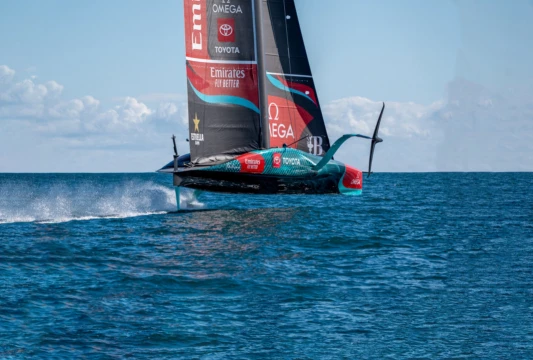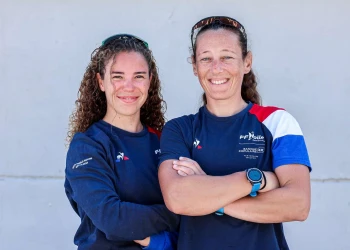
What We Learned from the 37th America’s Cup
The Louis Vuitton 37th America’s Cup provided insight into the future of professional sailing, showcasing what works and what doesn’t in high-performance racing. Here are some key takeaways from the event:
1. 49er Sailing: The Ideal Training Ground for Pro Sailors
The 49er class has proven to be the most competitive training environment for future professional sailors. Unlike single-handed Olympic classes or boats like the Moth, 49er sailors must work together as a team, closely mimicking the dynamics of professional sailing. Success in close and fast racing, where interpersonal relationships are under pressure, makes skiff racing a crucial stepping stone to events like the America’s Cup and all pro sailing.
2. Collaborative Decision-Making: Kiwis Lead the Way
The New Zealand team’s use of all four sailors for decision-making was a key factor in their success. Rather than relying on just one or two voices, the Kiwis shared responsibilities and insights, leading to better on-the-water decisions. The trimmers Blair Tuke and Andy Maloney were used as part of sailing decision making system in Emirates New Zealand, and contributed mightily to their racing dominance. This collaborative approach highlights the value of using all available resources in a high-pressure environment.
3. Windward-Leeward Starts Trump Reaching Starts
Windward-leeward starts, as seen in the America’s Cup, are far superior to the reaching starts used in SailGP. The America’s Cup demonstrated that windward-leeward starts bring more structure and fairness to the racing, reducing the randomness and jeopardy often associated with reaching starts. Fans want to see the best teams rise to the top based on skill, not on random factors at the start line. This format helped make the America’s Cup racing more compelling and easier to follow.
4. No Headsails, Less Drama
One of the drawbacks of the current America’s Cup format is the lack of a headsail, which has reduced both the excitement and the jeopardy involved in maneuvers. Bringing back this element could inject more action into the races and increase the spectacle. Further, with the leading boat always having the air disturbance advantage it diminished a lot from the options and strategies the trailing team could employ to get back into races.
5. Sailor Visibility and Personalities Matter
One of the biggest criticisms of the current America’s Cup is that the sailors are too hidden from view, which makes it harder for fans to connect with the competitors. Sailing is a sport driven by individual skill and personality, and when the sailors are not visible, it detracts from the human side of the competition. Showcasing the sailors more prominently would help grow the sport’s appeal.
6. Women and Youth Need a Better Format
Adding Youth and Women’s AC regattas that reuse the test boats was a big win in concept, but less so as a great regatta. Teams put in lots of effort and lots of great sailors showed up, but the racing and format meant it felt more like a lottery than it needed to. The winner takes all concept for the final race is almost never the right answer in sailing, and that showed in both the Women’s and Youth regattas.
A better format would have been best of five races for both semi finals and finals, probably for quarter finals too so the viewer could gain an investment in seeing the winners win in ways we believe matter. If the cost of running so many races is too great, make the races shorter and we could even go back to running races simultaneously to save time (before the final).
7. Stable Equipment Leads to Better Racing
Frequent changes in equipment have hurt the America’s Cup in recent years. The most exciting races come when teams have had some iterative improvements in boat design and can focus on strategy and speed. In contrast, when new boats or equipment are introduced, there is such a huge disparity in speed that the racing suffers and is less competitive. History shows that some of the best America’s Cup races came during the era of the International America’s Cup Class (IACC) boats, and it’s taken 17 years to recapture that level of excitement.
8. Shorter Races with Boundaries
The 25-minute races with sideline boundaries and a windward-leeward course proved to be the best way to showcase the sport. This format provided close racing, was easy for fans to understand, and kept the action intense. The shorter race times also allowed for more dynamic viewing experiences, keeping audiences engaged. If the boats were a little more under control the super yacht crowd could have been even closer to the sidelines and playing field even more into a stadium atmosphere.
9. Simplified Pre-Starts Work Best
Two-minute pre-starts are more than enough to set the stage for a competitive race. In the past, pre-start maneuvering took too long and was difficult for casual viewers to follow. The America’s Cup showed that shorter, more straightforward pre-starts keep the focus on the race itself, without unnecessary complications.
10. Minimizing Tack Loss Enhances Action
To keep the action fast and exciting, boats need to be able to tack with minimal speed loss. The more seamless the maneuvers, the more engaging the race becomes for fans, ensuring that the competition remains tight and the outcome uncertain until the end.
The 37th America’s Cup taught us valuable lessons about what makes great racing. A focus on teamwork, stability in equipment, fair starts, and accessible race formats are all crucial to maintaining the sport’s excitement and viewer engagement. Let’s hope that New Zealand and GBR keep pushing the Event forward.





